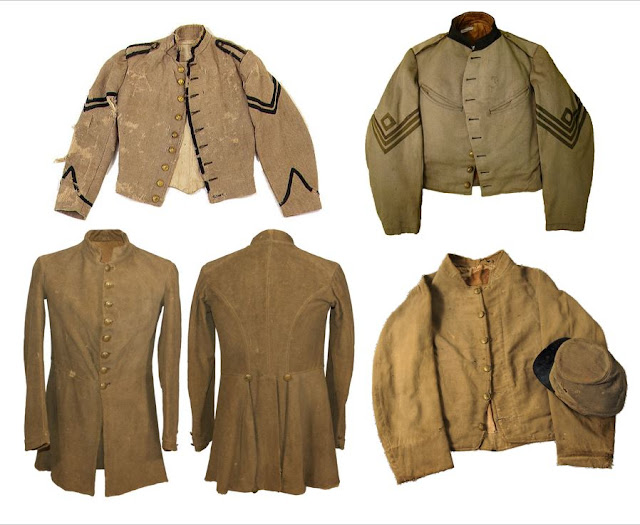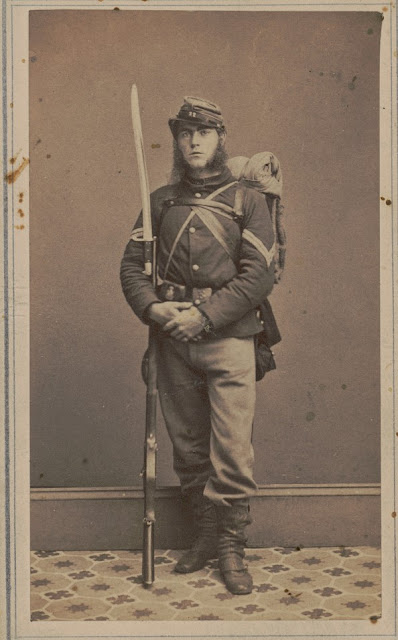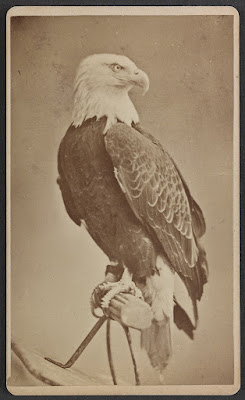From Bunker Hill to Perrysburg: Tassels Tie the Revolutionary War to the Civil War
When the Fort Meigs Rifles left Perrysburg, Ohio in April 1861 to take part in the Civil War, the ladies of Perrysburg sent them a silk national flag with symbols stretching back to the birth of the nation. Not only was the company named the Fort Meigs Rifles in honor of nearby Fort Meigs, an important battle site during the War of 1812, but the flag bore Commodore Oliver Hazard Perry’s motto from the Battle of Put-In-Bay. Intriguingly, the flagstaff carried two tassels with connections to the Battle of Bunker Hill, one of the earliest engagements of the Revolutionary War.
“The flag is a beautiful one, bearing the motto of Commodore
Perry “Don’t Give Up the Ship’ in gold letters,” the Perrysburg Journal
reported. [The town of Perrysburg was named for Commodore Perry.] “On
the flag there are two tassels, which were on a flag borne at the Battle of
Bunker Hill. These tassels were given to the ladies who presented the flag by
Mrs. Roach, whose grandfather carried the flag at the Battle of Bunker Hill.”
That last comment always intrigued me- tassels carried on a
flag at the Battle of Bunker Hill? That is a wow moment, but I wanted to
establish a firm connection with the claim so I dove into the rabbit hole and
made some very interesting discoveries along the way.
The first thing I needed to do was establish the identity of “Mrs.
Roach.” Perrysburg wasn’t a large town at the outbreak of the Civil War; the
1860 census showed a population of 1,494. It only took a short while to view
the entirety of the town census online at Ancestry.com, and in so doing
discovered that there was only one Mrs. Roach in 1860: Amelia Ann Roach, the
wife of town stationmaster Andrew Roach. Her obituary showed that she died of
consumption at age 38 on April 13, 1868. That said, she was both alive and
living in Perrysburg in the spring of 1861, so I’m pretty certain we can
establish that Amelia Roach was the “Mrs. Roach” who presented the regiment
with the tassels. But what is her connection to the Battle of Bunker Hill?
Unfortunately, Find-A-Grave was less than helpful. It listed
her maiden name as Herald and multiple searches in Ancestry failed to uncover
anything. Online issues of the Perrysburg Journal exist on Newspapers.com,
so I navigated to the issues dating right after her death and was rewarded with
a full obituary in the April 24, 1868, issue. It turns out her maiden name wasn’t
Herald- it was Heald! And that her parents’ names were Ebenezer and Margery,
which just so happened to be the name of one of Andrew and Amelia’s daughters.
The obituary also mentioned she was born in Baltimore, Maryland
in December 1829 and that she married Andrew Roach in Columbus, Ohio in 1851.
The couple lived in Dayton, Ohio until October 1859 when Andrew, working for
the Cincinnati, Hamilton, and Dayton Railroad, transferred to the railroad
station in Perrysburg.
So now it was time to search for Ebenezer Heald. He was a bit
easier to find. Birth records from the town of Carlisle, Massachusetts showed
that Ebenezer was born July 4, 1802, to Simon and Betsey Heald. To be clear,
Carlisle did not become a town until 1805 but was known as the Carlisle district
of nearby Concord, Massachusetts. Ebenezer shows up in both the 1830 census in
Baltimore (matches up with Amelia’s birthplace) and the 1850 census in (you
guessed it) Dayton, Ohio where he listed his occupation as a lime burner.
Ebenezer died December 31, 1855, and was buried at Woodland Cemetery in an
unmarked grave. Simon’s birthplace gives us that Massachusetts connection, so
we’re getting closer to Bunker Hill!
Now to find Ebenezer’s father Simon Heald- that proved even
easier. He was born on March 6, 1774, in Carlisle, Middlesex Co., Massachusetts
to Captain Samuel and Mary Heald. Now the newspaper article claimed that Amelia’s
grandfather (who we now know is Simon) carried the flag at Bunker Hill. Given
that the battle occurred in June 1775 when young Simon was scarcely a toddler,
I highly doubt he carried the flag in that battle. But he was born to a Captain
Heald? Who was he?
 |
| 1926 stamp issue commemorating the 150th anniversary of the Battles of Lexington and Concord featuring "The Minute Man." Samuel Heald was one of them, a Carlisle Minuteman. |
It turns out that Captain Samuel Heald is one of the Revolutionary
War heroes of Massachusetts. According to the Discovering Colonial Carlisle website,
“Heald was one of the leaders of the Carlisle Minutemen who marched to the
Alarm on April 19, 1775. He later served as an officer in the Continental Army
and after the war served as Town Treasurer and Selectman.” His homestead now
serves as the Carlisle Historical Society’s museum and is open to the public.
A Carlisle Minuteman and at the opening shots of the Revolutionary
War? According to local history, “on the morning of the 19th of
April 1775, 19 men, called together from the neighboring hamlets by the drum of
Timothy Wilkins and the horn of James Kemp, started for Concord under the
direction of Lieutenant James Russell and Samuel Heald, to join in the
fight at the Old North Bridge and pursue the retreating foe back to Boston.” The
Carlisle Minutemen wore a sprig of pine in their hats as they marched to
Concord that morning.
 |
| The fight at Old North Bridge near Concord, Massachusetts, April 19, 1775. |
State records of Massachusetts further show that Samuel Heald
served for many years in Captain Thomas J. Barrett’s 7th Company of the
3rd Middlesex County Regiment of Massachusetts Militia as a first
lieutenant and later as its captain. I think we’ve established a solid connection
to the Heald family at Concord, but how does that tie into Bunker Hill fought
two months later closer to Charlestown?
It turns out the Massachusetts militia, bolstered by
thousands of reinforcements from throughout New England, pursued the Redcoats
back to Boston and soon the nascent Colonial army under General Artemas Ward
had the British under siege. In the meantime, the various militia companies
were organized into regiments and the Carlisle Minutemen (of Middlesex County) were
folded into one of these regiments; which one, however, is unclear.
State records indicate that militia from Middlesex County
served in the 1st, 6th, 8th, 9th, and
13th Regiments. Looking at a map of the Battle of Bunker Hill, only
the 9th Regiment from the list above was present on the field. So,
if the story is true, Samuel Heald would have fought at Bunker Hill with the 9th
Massachusetts.
 |
| What kind of flag did Samuel Heald carry at Bunker Hill? Tradition says it may be similar in design to the flag shown above, a derivative of the New England flag. |
About 1,600 militiamen under William Prescott seized Breed’s Hill and Bunker Hill near Charlestown on the night of June 16-17, 1775. The 9th, along with the 10th, 11th, 16th, 18th, 19th, 22nd, and 24th Regiments, formed into line atop Breed’s Hill and commenced digging a redoubt. The following day, the British marched straight up the hill, contemptuous of the colonials, and suffered heavy casualties before eventually driving the Americans back towards Bunker Hill.
If
the original newspaper story is true, Samuel Heald carried the regimental flag
at Bunker Hill and later passed those tassels down to his family. So the Perrysburg
Journal got most of the story right- it’s just that it was Amelia Roach’s
great-grandfather, not her grandfather, who carried that flag at Bunker Hill. A
pretty amazing story!
Where are those tassels today? I wish I knew. The original
Fort Meigs Rifles flag resides today at the Hancock County Historical Museum in
Findlay, Ohio. But the tassels, an amazing connection to the birth of the
nation 250 years ago, are lost to history…
Sources:
“Our Flag is
There!” Perrysburg Journal (Ohio), May 9, 1861, pg. 2
Obituary for
Amelia Roach, Perrysburg Journal (Ohio), April 24, 1868, pg. 3











Comments
Post a Comment